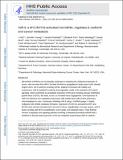| dc.contributor.author | Prabhala, Harsha | |
| dc.contributor.author | Mestdagh, Pieter | |
| dc.contributor.author | Muth, Daniel | |
| dc.contributor.author | Teruya-Feldstein, Julie | |
| dc.contributor.author | Westermann, Frank | |
| dc.contributor.author | Speleman, Frank | |
| dc.contributor.author | Vandesompele, Jo | |
| dc.contributor.author | Ma, Li-Jun | |
| dc.contributor.author | Young, Jennifer J | |
| dc.contributor.author | Pan, Elizabeth | |
| dc.contributor.author | Reinhardt, Ferenc | |
| dc.contributor.author | Onder, Tamer T | |
| dc.contributor.author | Valastyan, Scott John | |
| dc.contributor.author | Weinberg, Robert A | |
| dc.date.accessioned | 2018-07-13T15:58:12Z | |
| dc.date.available | 2018-07-13T15:58:12Z | |
| dc.date.issued | 2010-02 | |
| dc.identifier.issn | 1465-7392 | |
| dc.identifier.issn | 1476-4679 | |
| dc.identifier.uri | http://hdl.handle.net/1721.1/116977 | |
| dc.description.abstract | MicroRNAs (miRNAs) are increasingly implicated in regulating the malignant progression of cancer. Here we show that miR-9, which is upregulated in breast cancer cells, directly targets CDH1, the E-cadherin-encoding messenger RNA, leading to increased cell motility and invasiveness. miR-9-mediated E-cadherin downregulation results in the activation of β-catenin signalling, which contributes to upregulated expression of the gene encoding vascular endothelial growth factor (VEGF); this leads, in turn, to increased tumour angiogenesis. Overexpression of miR-9 in otherwise non-metastatic breast tumour cells enables these cells to form pulmonary micrometastases in mice. Conversely, inhibiting miR-9 by using a 'miRNA sponge' in highly malignant cells inhibits metastasis formation. Expression of miR-9 is activated by MYC and MYCN, both of which directly bind to the mir-9-3 locus. Significantly, in human cancers, miR-9 levels correlate with MYCN amplification, tumour grade and metastatic status. These findings uncover a regulatory and signalling pathway involving a metastasis-promoting miRNA that is predicted to directly target expression of the key metastasis-suppressing protein E-cadherin. | en_US |
| dc.description.sponsorship | Life Sciences Research Foundation Fellowship | en_US |
| dc.description.sponsorship | Margaret and Herman Sokol Award | en_US |
| dc.description.sponsorship | National Institutes of Health (U.S.) (Pathway to Independence Award (K99/R00)) | en_US |
| dc.description.sponsorship | Howard Hughes Medical Institute (Undergraduate Fellowship) | en_US |
| dc.description.sponsorship | Breast Cancer Research Program (U.S.) (Predoctoral Fellowship) | en_US |
| dc.description.sponsorship | National Institutes of Health (U.S.) (Grant) | en_US |
| dc.description.sponsorship | Ludwig Center for Molecular Oncology at MIT | en_US |
| dc.publisher | Springer Nature | en_US |
| dc.relation.isversionof | http://dx.doi.org/10.1038/ncb2024 | en_US |
| dc.rights | Article is made available in accordance with the publisher's policy and may be subject to US copyright law. Please refer to the publisher's site for terms of use. | en_US |
| dc.source | PMC | en_US |
| dc.title | miR-9, a MYC/MYCN-activated microRNA, regulates E-cadherin and cancer metastasis | en_US |
| dc.type | Article | en_US |
| dc.identifier.citation | Ma, Li, Jennifer Young, Harsha Prabhala, Elizabeth Pan, Pieter Mestdagh, Daniel Muth, Julie Teruya-Feldstein, et al. “miR-9, a MYC/MYCN-Activated microRNA, Regulates E-Cadherin and Cancer Metastasis.” Nature Cell Biology (February 21, 2010). | en_US |
| dc.contributor.department | Broad Institute of MIT and Harvard | en_US |
| dc.contributor.department | Massachusetts Institute of Technology. Department of Biology | en_US |
| dc.contributor.department | Massachusetts Institute of Technology. Division of Comparative Medicine | en_US |
| dc.contributor.mitauthor | Ma, Li-Jun | |
| dc.contributor.mitauthor | Young, Jennifer J | |
| dc.contributor.mitauthor | Pan, Elizabeth | |
| dc.contributor.mitauthor | Reinhardt, Ferenc | |
| dc.contributor.mitauthor | Onder, Tamer T | |
| dc.contributor.mitauthor | Valastyan, Scott John | |
| dc.contributor.mitauthor | Weinberg, Robert A | |
| dc.relation.journal | Nature Cell Biology | en_US |
| dc.eprint.version | Author's final manuscript | en_US |
| dc.type.uri | http://purl.org/eprint/type/JournalArticle | en_US |
| eprint.status | http://purl.org/eprint/status/PeerReviewed | en_US |
| dc.date.updated | 2018-07-12T18:23:41Z | |
| dspace.orderedauthors | Ma, Li; Young, Jennifer; Prabhala, Harsha; Pan, Elizabeth; Mestdagh, Pieter; Muth, Daniel; Teruya-Feldstein, Julie; Reinhardt, Ferenc; Onder, Tamer T.; Valastyan, Scott; Westermann, Frank; Speleman, Frank; Vandesompele, Jo; Weinberg, Robert A. | en_US |
| dspace.embargo.terms | N | en_US |
| dc.identifier.orcid | https://orcid.org/0000-0002-0895-3557 | |
| mit.license | PUBLISHER_POLICY | en_US |
